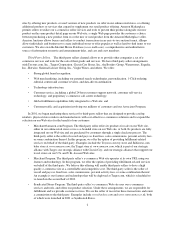Amazon.com 2001 Annual Report Download - page 21
Download and view the complete annual report
Please find page 21 of the 2001 Amazon.com annual report below. You can navigate through the pages in the report by either clicking on the pages listed below, or by using the keyword search tool below to find specific information within the annual report.commercial agreements, or both. We may, in the future, enter into further amendments of our commercial
agreements. Although these amendments did not affect the amount of unearned revenue previously recorded by
us, the timing of revenue recognition of these recorded unearned amounts has been changed to correspond with
the terms of the amended agreements. To the extent we believe any such amendments cause or may cause the
compensation to be received under an agreement to no longer be fixed or determinable, we limit our revenue
recognition to amounts received, excluding any future amounts not deemed fixed or determinable. As future
amounts are subsequently received, such amounts are incorporated into our revenue recognition over the
remaining term of the agreement.
We Face Significant Inventory Risk Arising Out of Changes in Consumer Demand and Product Cycles
We are exposed to significant inventory risks as a result of seasonality, new product launches, rapid changes
in product cycles and changes in consumer tastes with respect to our products. In order to be successful, we must
accurately predict these trends and avoid overstocking or under-stocking products. Demand for products,
however, can change significantly between the time inventory is ordered and the date of sale. In addition, when
we begin selling a new product, it is particularly difficult to forecast product demand accurately. A failure to
optimize inventory within our fulfillment network will harm our shipping margins by requiring us to make split
shipments from one or more locations, complimentary upgrades, and additional long-zone shipments necessary
to ensure timely delivery. As a result of our agreements with Toysrus.com, Babiesrus.com, and Target, these
parties will identify, buy, manage and bear the financial risk of inventory obsolescence for their corresponding
stores and merchandise. As a result, if any of these parties fail to forecast product demand or optimize inventory,
we would receive reduced service fees under the agreements and our business and reputation could be harmed.
The acquisition of certain types of inventory, or inventory from certain sources, may require significant
lead-time and prepayment, and such inventory may not be returnable. We carry a broad selection and significant
inventory levels of certain products, such as consumer electronics, and we may be unable to sell products in
sufficient quantities or during the relevant selling seasons.
Our ability to receive inbound inventory efficiently or ship completed orders to customers may be
negatively effected by inclement weather, fire, flood, power loss, earthquakes, acts of war or terrorism or acts of
God.
Any one of the factors set forth above may require us to mark down or write off inventory, which will
adversely affect our operating results.
If We Do Not Successfully Optimize and Operate Our Fulfillment Centers, Our Business Could Be
Harmed
If we do not successfully operate our fulfillment centers, it could significantly limit our ability to meet
customer demand. Most of our fulfillment centers are highly automated, and we have had limited experience with
automated fulfillment centers. Because it is difficult to predict sales increases, we may not manage our facilities
in an optimal way, which may result in excess inventory, warehousing, fulfillment and distribution capacity. In
January 2001, we closed our fulfillment center in McDonough, Georgia and decided to operate the Seattle,
Washington fulfillment center on a seasonal basis, if necessary. Under some of our strategic alliances, we
maintain the inventory of other companies in our fulfillment centers, thereby increasing the complexity of
tracking inventory in and operating our fulfillment centers. Our failure to properly handle such inventory would
result in unexpected costs and other harm to our business and reputation.
We May Not Be Able to Adequately Protect Our Intellectual Property Rights or May Be Accused of
Infringing Intellectual Property Rights of Third Parties
We regard our trademarks, service marks, copyrights, patents, trade dress, trade secrets, proprietary
technology and similar intellectual property as critical to our success, and we rely on trademark, copyright and
12
























